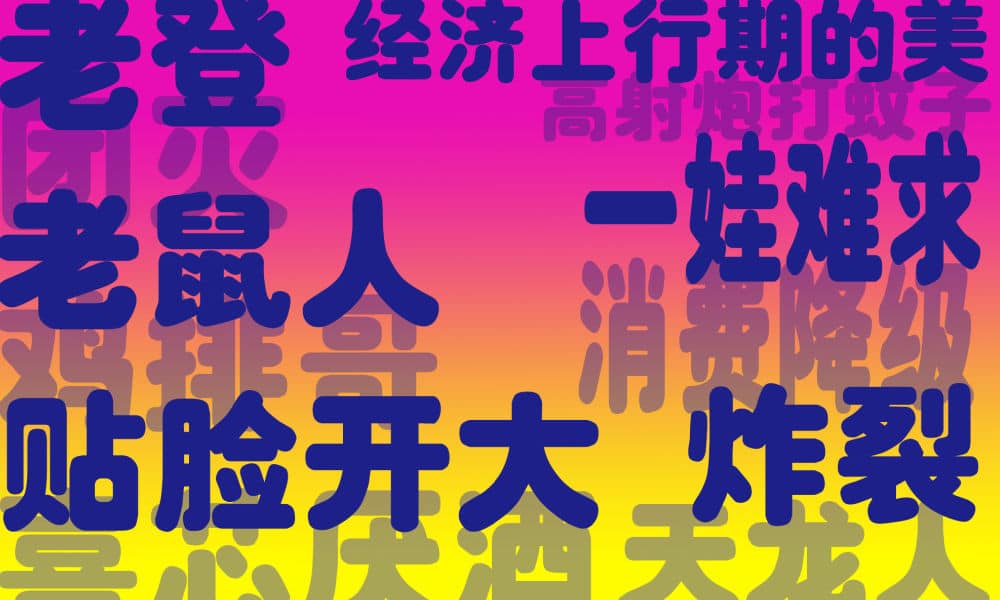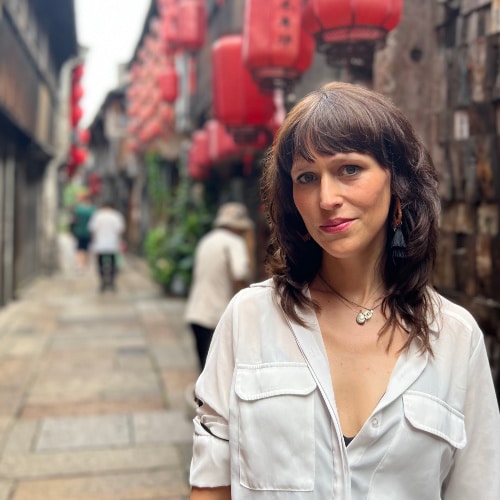Featured
Op-Ed: Your Use of “Netizen” Hurts Responsible China Coverage
It’s not innocent jargon. Not anymore.
Published
8 years agoon

Far from innocent jargon, the word ‘netizen’ has political implications in its use today and should not be casually tossed around, says Beijing-based journalist Dave Yin. In this op-ed contribution, Yin responds to our recent article “Netizens or Not?“
It’s unlikely that when internet theorist and author Michael F. Hauben coined the word “netizen” more than thirty years ago, he would have imagined that, one day, on the other side of the world, a few handfuls of Western reporters and media critics covering China would be divided: in one camp applauding and in the other cursing his creation. It’s equally unlikely he’d recognize at first glance what his word has come to mean in 2018 – and to whom.
Common thought is that whether or not “netizen” should be used, and what it means, are at the heart of this debate, which by now spans publications both big and small, free and censored. It hasn’t gotten us anywhere.
But in view of China’s escalation of online policing and digital surveillance, the concept of “netizen” is evolving, as must its coverage in Western media. Far from innocent jargon, the word today has political implications and a growing potential for harm, one Western media must recognize if it is to conduct responsible reporting.
A Western interpretation
When considering the word “netizen,” it helps to know what one is talking about. Namely, pick a definition, and stick with it.
Scenario A)
One clear-cut definition offered by the Atlantic designates a unique identity; young, wealthy, educated Chinese urbanites and/or politically active individuals in online communities adept at skirting censorship.
Here, simple protocol applies. Writers using “netizen” must first make sure the subjects of their story actually match this description. Then, they must assess whether these complex socioeconomic and political elements are evident in this word. Hint: they’re not. Inevitably, writers should be explaining these elements to accompany the use of this term in each article it appears in. Anything short of this is incomplete reporting.
Scenario B)
If broadly defined to be a synonym to “Chinese internet users,” as is more often the case, then several questions emerge: Why do Chinese internet users need a special label in the first place? Why is “Chinese internet user” inadequate when this type of terminology works for everyone else? If research (paywall) suggests the online habits of Chinese are similar to the rest of us, what are we trying to accomplish by othering them?
Self-applied labels
In advocacy reporting, we try to respect a person’s self-applied labels, such as with race or sexual orientation, so I appreciate the irony when I say that just because Chinese people call themselves “netizens” doesn’t necessarily mean we should.
Be it when describing race, sexual orientation, disability, etc. there is a general effort to use terminology that centers the person, and not the circumstance, which is often complex. “Person with impaired vision,” “a cisgender gay man,” “the woman, who identifies as a second-generation Filipino immigrant,” “individuals claiming to be members of the Anonymous collective” are infinitely better than “the blind,” “the gay,” “the Filipino,” “Anonymous.” In pieces where nuance and individuals matter, these words do more than fill up space.
“Netizen,” as it is currently used, erases both.

What’s more, these often political labels emerged in societies with freedom of association where one makes a statement simply by publicly identifying. By contrast, what does it mean to label yourself with something as vague and abstract as “netizen” in a society that doesn’t allow such freedom, and what effect does it have when Western media take up this cause?
A Chinese strategy
The self-applied label argument is also unsound when you consider that “netizen” is actually a mistranslation of the word “wǎngmín” (网民).
In wǎngmín 人民 (people), nóngmín 农民 (farmer), jūmín 居民 (resident), yímín 移民 (migrant), yúmín 渔民 (fisherman), and míngē 民歌 (folk song), “mín” 民 simply means “people,” without any “citizen” connotation, and therefore “wǎngmín” 网民 really just means “internet people/people on the internet.”
In other words, “netizen” and “wǎngmín” are faux amis. It’s a mistake that Western media has allowed to proliferate and one that we must now contend with.
While the use of the English word by ordinary Chinese and private Chinese media could boil down to guileless ignorance towards English nuance, by contrast, “wǎngmín,” when applied by the Chinese government and its mouthpieces, is part of deliberate national policy. As described by Manya Koetse in her analysis, the Chinese term is an official category of Chinese nationals on which the CCP imposes severe restrictions.
What ramifications are there for Western media in not consciously decoupling these wildly different interpretations by different actors? By casually tossing the word around, do we not run the risk of normalizing Chinese internet policy?
While we, working in the Far East, may feel at times that our work is isolated, it should be noted that people are, in fact, reading, for better or worse.
“[‘Netizen’] has been used when reporting on China for a decade+ [sic] in order to relieve journalists of understanding what they’re reporting on,” one Reddit user (Western netizen?) writes. “Today it is a lazy way to assume all internet users in China think the same way by f*cking lazy journalists.”
“Netizen” may well stick around. China’s emerging digital policies have all but ensured it. But we owe it to our readers and the people we cover to get with the program, to evolve our terminology and critical judgment at the same pace as the subject matter.
We need to understand that the benefits of its selective, judicious use, as a result of explicit purpose, come from highlighting and decoding China’s socioeconomic and political situation, not from generalizing 772 million individuals, and least of all from othering them or normalizing their constraints. It may help everyone’s understanding of this country, including our own.
By Dave Yin
Follow @whatsonweibo
Spotted a mistake or want to add something? Please let us know in comments below or email us.
©2018 Whatsonweibo. All rights reserved. Do not reproduce our content without permission – you can contact us at info@whatsonweibo.com.
Featured
China’s 2025 Year in Review in 12 Phrases
Andrew Methven’s favorite Chinese phrases of the year, a special feature by RealTime Mandarin.
Published
5 days agoon
December 31, 2025
Dear Reader,
Happy New Year! A new year is, undoubtedly, filled with new resolutions. I have a few on my list, and maybe we have some in common—like reading more books (my new e-reader is arriving from Shenzhen tomorrow!) and being more diligent about practicing my new Chinese vocabulary.
If upping your Chinese is also on your list for 2026, Andrew Methven’s newsletter, RealTime Mandarin, is a must-follow. It’s a free weekly resource that helps you improve your Mandarin in just 10 minutes a week, specifically designed for intermediate to advanced learners. I’ve been following Andrew’s work for over three years and love how he makes mastering the language more manageable, so I highly recommend giving it a follow.
Looking back on 2025, here is Andrew’s curated pick of 12 Chinese phrases to remember.
Every year at this time, we wrap up with our own “unofficial” list of top words and phrases. These are expressions that probably didn’t exist a year ago, but have gone viral and become mainstream lingo over the last 12 months. We’ve picked 12 phrases and avoided overlap with the “official” top ten lists.
Most of these phrases were newly invented or popularised in 2025. So if you haven’t been to China this year, you probably won’t know them.
And as always, these phrases began life in the most unlikely places: from Japanese Manga to Taiwanese baseball; from American online games, to viral moments shared by Chinese students living in the UK.
As we pulled this list together, we noticed something interesting: That it’s full of contradictions. According to these 12 phrases, and the trends they represent, it seems that for any one trend you can say is happening in China right now, you could also find another one that proves the exact opposite is true.
So we decided to explain our favourite phrases of 2025 through five contradictions:
⚔️ Contradiction #1: Consumers are not buying, but are buying like crazy
In January, consumer confidence collapsed, with retail sales in Shanghai and Beijing declining steeply. The broader trend of “consumption downgrading” (消费降级) began in 2024, with policymakers pushing for “rational consumption” (理性消费).
Yet 2025 also saw unbelievable and irrational sales success stories.
“Hard to get a Labubu” (一娃难求) became a trending phrase in June following the explosion of the Labubu (拉布布), an ugly-cute, kind-of-scary toy. Other consumer successes included the move into flavoured beer by ice tea giant, Mixue Bingcheng (蜜雪冰城).
⚔️ Contradiction #2: Businesses had an awful year, but a great year
In April, as the tariff war escalated, many of China’s exporters feared the worst: a “total wipeout” (团灭) of their sales.
China’s tech darling Xiaomi (小米) started the year strong with soaring EV sales, but by the end of the year faced a string of consumer backlashes.
While another EV brand, Neta (哪吒), battled collapse rumours at the start of the year, and outdoor brand, Arc’teryx, was boycotted after its disastrous “mind-blowing” (炸裂) exploding mountain PR stunt.
China’s big three ecommerce platforms — JD, Alibaba, and Meituan — continued in their “tripartite rivalry” (三足鼎立), each invading the others’ turf in a race to the bottom on price.
Yet 2025 also saw stunning business breakthroughs, such as when chipmaker Cambricon (寒武纪), fuelled by China’s “domestic substitution” (国产替代) push, surged from loss-making startup to briefly become China’s most valuable stock, surpassing liquor brand, Moutai (贵州茅台) in the process.
With investors coining a new phrase: “choosing chips over liquor” (喜芯厌酒).
⚔️ Contradiction #3: Government policy was forward-thinking, but also backfired spectacularly
2025 was the year of “Embodied intelligence” (具身智能), after the government prioritised this technology in its Work Report in March.
The following month, Beijing hosted the world’s first “humanoid robot half marathon” (人形机器人半马). And in November, XPENG’s humanoid robot, IRON, stunned observers with its lifelike female form.
Also in March, the State Council announced measures to stamp out “involuted” work practices. And by April, some of China’s tech giants had responded with the introduction of “anti-involution” (反内卷) policies, which has been an ongoing theme throughout the year.
But other government policies backfired spectacularly.
Strict alcohol bans introduced for government officials were criticised as “bureaucratic overreach” (层层加码), the introduction of the K-visa (K签) aimed at attracting foreign talent was derided on social media as youth unemployment sat at 19%. Mosquito eradication efforts in Guangdong were criticised as “using a cannon to kill a fly” (高射炮打蚊子) following heavy-handed measures reminiscent of COVID.
And in Hangzhou, a water contamination scandal resurrected one of our top phrases from 2024 when locals blasted the city government as an “unprofessional team” (草台班子).
⚔️ Contradiction #4: Youth are lying flat, but are fighting back
In August, we discussed a new phrase which had emerged: “rat people” (老鼠人).
It started when Chinese students in the UK began sharing “low-energy rat people” (低能量老鼠人) videos of their isolated lives enduring long, dark British winters. The meme took off as young people embraced “low energy” lifestyles.
But not all youngsters were taking it easy and giving up.
A Chery Auto (奇瑞) graduate employee went into “full confrontation mode” (贴脸开大) with his employer in August after refusing to work Saturdays, citing the government’s “anti-involution” (反内卷) directive.
And earlier in the year, China National Nuclear Corporation (CNNC) faced “widespread condemnation” (千夫所指) after its tone-deaf PR campaign celebrated how it had received 1 million applications for just 8,000 graduate positions.
⚔️ Contradiction #5: Influencers are out, but influencers are in
2025 saw established celebrities fall out of favour with their fans.
High profile entrepreneurs Lei Jun (雷军) and Jia Guolong (贾国龙), were branded “out-of-touch middle-aged men” (老登).
Meanwhile, unlikely viral stars emerged from the grassroots. Director Fang (房主任), a 50-year-old divorced housewife from Shandong, became one of China’s most-watched stand-up comics.
And a street vendor selling 6-yuan fried chicken cutlets in Jingdezhen (景德镇) became “Chicken Cutlet Brother” (鸡排哥) after a customer’s Douyin video of him cooking and serving customers went viral.
Of course, some unchanging themes continued to draw attention in 2025 as in previous years.
Like the abuse of power and privilege by China’s “celestial dragons” (天龙人): the next generation of elites who “leverage family ties” (拼爹) for their own interests.
So, let’s dive in!
Our Favourite Phrases of 2025
1. Mind-blowing
炸裂 zhà liè
💬 一个标榜户外精神的户外品牌,在最脆弱的生态环境里,搞了一场炸裂的秀。
💬 An outdoor brand that claims to embody the spirit of nature put on a “spectacular” fireworks show in one of the most fragile ecosystems.
Background:
Internet slang which started in Japanese baseball to describe explosive performance. It gained popularity in Taiwan baseball to describe spectacular moments. In Mainland Chinese it describes stunning and sudden success — such as the overtaking of Moutai by semi chip maker, Cambricon (寒武纪).
“Mind-blowing” can also be used as an ironic statement when something goes mind-blowingly wrong, like Arc’teryx’s disastrous fireworks PR stunt in the Himalayas in September.
Related RTM content:
- Chinese AI chip maker briefly overtakes Moutai to become China’s most valuable listed company
- How the Arc’teryx fireworks fiasco is being discussed in China
- One Yuan iced water becomes China’s viral summer sensation
2. Total wipeout
团灭 tuán miè
💬 最坏的情况下,储能在美国的业务会被“团灭”。
💬 In the worst-case scenario, the energy storage business in the U.S. will be totally wiped out.
Background
Started as a gaming phrase in team-based video games like World of Warcraft and League of Legends to describe total team wipe outs (all members dying together). It extended beyond gaming to describe collective failures in exams, work, or daily life.
We first came across it listening in to discussions between Chinese exporters in the face of US tariffs and the growing tariff war.
Related RTM content:
- China’s exporters are feeling the pain
- 10 hot internet slang words you had no idea came from online gaming!
3. Out-of-touch middle-aged man
老登 lǎo dēng
💬 一连串的老登翻车,不能单纯用偶然和倒霉解释。
💬 When one boomer after another messes up, it’s not just coincidence or bad luck anymore.
Background
Originally a northern slang phrase, and a derogatory term for an old man (something like the English, “old git”). It took off this year after a number of high profile, self-inflicted PR disasters of high profile, influential male entrepreneurs. The most notable is Xiaomi founder, Lei Jun (雷军).
You can use it to describe any middle aged man who is condescending and appears out of touch with reality.
Related RTM content
4. Hard to get a Labubu
一娃难求 yì wá nán qiú
💬 火爆到“一娃难求”的LABUBU是泡泡玛特旗下“THE MONSTER”系列的一员。
💬 Labubu is part of Pop Mart’s “THE MONSTER” series, which has become so popular that it’s impossible to get one.
Background
One of the craziest shopping trends of 2025 — the obsession with these tiny, ugly, key ring toys made by Chinese company, Pop Mart. Since early 2025, images of Labubu filled social media feeds and become a must-have item for millions of fans and collectors in China.
Expect to see more from the Labubu in 2026.
Related RTM content:
5. “Chicken Cutlet Brother”
鸡排哥 jī pái gē
💬 最近,景德镇有个卖鸡排的大哥突然爆火,还被广大网友封为“鸡排主理人”。
💬 Recently, a man selling fried chicken in Jingdezhen suddenly went viral and was even dubbed the “chicken chop curator” by netizens.
Background
The “Chicken Cutlet Brother” (鸡排哥) story is one of our favourites from 2025. This 48-year-old overnight sensation is genuine, authentic, and unpolished – a refreshing change from the heavily curated content that dominated Chinese social media this year. His story echoes the “Second Uncle” (二舅) phenomenon we covered in 2022.
The sheer volume of memes and slang spawned by a single short video is staggering. Three phrases in China’s official top ten lists came directly from him. “Chicken Cutlet Brother” will likely become shorthand for authentic grassroots creators in 2026.
Related RTM content:
6. Rat person
老鼠人 lǎo shǔ rén
💬 今年以来,“低能量老鼠人的一天”系列短视频走红社交媒体,很多年轻人热衷于自我诊断为“低能量老鼠人”。
💬 This year, the short video series “A Day in the Life of a Low-Energy Rat Person” went viral on social media, with many young people eager to self-diagnose as such.
Background
The phrase “rat people” (老鼠人) began gaining traction in early 2025. It evolved from an earlier internet meme, “rat literature” (鼠鼠文学), a buzzword that first emerged in early 2023. By 2025, a related phrase emerged on social media: “low-energy rat people” (低能量老鼠人). It was first popularized by Chinese students in the UK, enduring long, dark winters in isolation.
It’s now become a way young people describe their low energy lifestyles.
Related RTM content:
7. Over-privileged elite
天龙人 tiān lóng rén
💬 这的确是中国“新天龙人”的普遍特点——他们是很真诚地认为,集众美于一身的人生赛道是理所应当的。
💬 This indeed reflects a common trait of the next generation of the privileged in China—they genuinely believe that inheriting multiple forms of privilege is their birthright.”
Background
Originates from the Japanese manga, One Piece by Oda Eiichiro, referring to the descendants of twenty kings who founded the World Government. These characters enjoy extreme privileges, and consider themselves superior to ordinary people.
In Chinese online discourse, the term has evolved into internet slang to describe privileged elites in real life who are disconnected from ordinary people, who possess power and resources, live luxurious lives, and operate above the rules that govern everyone else.
Related RTM content:
- What China’s biggest medical scandal of 2025 reveals about the deeper flaws in its healthcare system
- Social media post ignites debate over wealth, privilege, and corruption
- China reacts to Harvard graduation speech
8. Consumption downgrade
消费降级 xiāo fèi jiàng jí
💬 也只有走上消费降级,扩大食客基础的道路。
💬 The only way out is to embrace the consumption downgrade and broaden their customer base.
Background
Emerged around 2018 in response to economic pressures like high housing costs and slowing income growth. The explosive rise of discount e-commerce platforms like PDD (拼多多) became a symbol of this shift. The phrase represents a reversal of China’s decades-long consumption upgrade trend.
This year we’ve seen a number of major trends which fit the “consumption downgrade trend” — including the collapse of consumer confidence in Beijing and Shanghai, and incredible success of low priced convenience products like “one yuan iced cup” by tea brand, Goodme (古茗).
Related RTM content
- Consumer confidence collapses in Beijing and Shanghai
- One Yuan iced water becomes China’s viral summer sensation
9. Full confrontation mode
贴脸开大 tiē liǎn kāi dà
💬 一名00后奇瑞校招生李某凯“贴脸开大”,在收到公司周六开会的邮件后,直接回复拒绝,并且将邮件抄送公司高层,包括集团二把手。
💬 Li, a Gen Z Chery campus recruit, chose to confront it head-on by saying no to the Saturday meeting in an email, in which he copied the company’s senior executives, including the group’s second-in-command.
Background
Started online gaming where it describes high-risk, high-reward move of rushing directly up to an enemy and unleashing your ultimate ability at point-blank range. The phrase has evolved into internet slang to describe being direct or blunt.
It’s similar to “bringing up exactly what shouldn’t be mentioned” or being brutally frank, often used with a teasing or mocking tone. Just like a graduate employee at Chery did this year when he refused to attend Saturday training and meetings.
Related RTM content:
10. Choosing chips over liquor
喜芯厌酒 xǐ xīn yàn jiǔ
💬 在资本市场「喜芯厌酒」情绪托举下,寒武纪摇身变新王。
💬 Fueled by investor’s shift from liquor to chips, Cambricon is crowned the new king on the capital markets.
Background
A clever wordplay on the Chinese idiom “love the new, hate the old” (喜新厌旧), which is typically used to criticise disloyalty in relationships or fair-weather behaviour. The new version substitutes two characters while maintaining the original pronunciation: “new” (新 xīn) becomes “microchip” (芯 xīn), and “old” (旧 jiù) becomes “alcohol” (酒 jiǔ). This perfectly captures investor enthusiasm for semiconductor stocks like Cambricon while abandoning traditional alcohol companies like Moutai.
But the wordplay retains the original idiom’s critical edge, questioning whether Cambricon represents genuine long-term value or just another fleeting trend investors will abandon.
Related RTM content:
- Chinese AI chip maker briefly overtakes Moutai to become China’s most valuable listed company
- EV maker unveils life-like humanoid robot
11. Using a cannon to kill a fly
高射炮打蚊子 gāo shè pào dǎ wén zi
💬 重型机械来灭蚊,真有种高射炮打蚊子的既视感。
💬 Heavy machinery for mosquitoes? Brilliant strategy, just like using a cannon to kill a fly.
Background
Literally “using anti-aircraft guns to kill mosquitoes”, which is a xiehouyu (歇后语), a traditional two-part allegorical saying where a vivid scenario delivers its punchline through absurd imagery. The phrase describes massively disproportionate responses to minor problems. While not coined in 2025, it became popular this year as commentary on heavy-handed government policies, particularly Guangdong’s extreme mosquito eradication campaigns.
It perfectly captures public frustration with bureaucratic overreach, when authorities deploy maximum force against minimal threats.
Related RTM content:
- Mosquito eradication efforts in Guangdong are going too far
- Hangzhou authorities mishandle tap water pollution incident
12. The beauty of an economic upturn
经济上行期的美 jīng jì shàng xíng qī de měi
💬 最近刷到越来越多人开始怀念10年代经济上行期的美。
💬 Lately, I’ve seen more and more people reminiscing online about the beauty of the economic upturn during the 2010s.
Background
This has become a viral hashtag on Chinese social media. It refers to roughly 2001-2015, when China’s economy maintained near double-digit growth and quality of life visibly improved year after year. Upward mobility felt tangible. Opportunities seemed everywhere.
This optimism defined early iterations of China’s largest online shopping festival, Double 11, launched in 2009, when it was ok to “consume and be happy” (消费即幸福).
But for many, that sense of optimism has now faded.
Related RTM content:
By Andrew Methven
Spotted a mistake or want to add something? Please let us know in comments below or email us. First-time commenters, please be patient – we will have to manually approve your comment before it appears.
©2025 Eye on Digital China/What’s on Weibo. All rights reserved. Do not reproduce our content without permission – you can contact us at info@whatsonweibo.com.
Featured
China’s 10 Biggest Social Media Stories of 2025
From top trends to platform scandals, these were the biggest online topics of the year.
Published
6 days agoon
December 30, 2025
Entering 2026, let’s take this time to reflect on a year of social media in China and the most noteworthy trending stories.
This is a list of major controversies & online moments that not only went completely viral but were also intrinsically connected to China’s social media sphere, either because they blew up on Weibo, originated on Douyin, or would not have even come to light if it weren’t for Xiaohongshu or other Chinese apps.
This is my pick of the top 10 topics and discussions that stood out most this year, capturing the broader sentiments shaping China’s social media landscape in 2025.
(PS: The items on this list are numbered chronologically and are not indicative of the importance/weight of the story.)
10. The ‘TikTok Refugee’-Xiaohongshu Honeymoon

At the beginning of 2025, a rare moment unfolded on Chinese social media. As American TikTok users faced a looming U.S. ban, they migrated to the Chinese app Xiaohongshu. This massive influx of so-called “TikTok refugees” (TikTok 难民) unexpectedly propelled Xiaohongshu to the number-one spot in app stores across the U.S. and beyond.
While the movement initially began as a tongue-in-cheek protest mocking U.S. authorities’ panic over Chinese companies stealing data, it soon turned into a genuine moment of cultural connection, as international users began building real relationships with the Chinese community on a fully domestic platform—sharing recipes, discussing culture, and practicing language.
Amid geopolitical tensions and a desire for cultural exchange, the fictional character ‘Li Hua’ unexpectedly emerged as a bridge between Chinese and American netizens. Li Hua (李华) is a familiar figure in China’s English writing exams, often used as a ‘stand-in’ for students to write letters to an imaginary foreign friend. Chinese users began digging up old exam papers and sharing the letters they had written years ago, often with captions like “Why didn’t you reply?” as a playful suggestion that Chinese students had been reaching out to foreign friends for years without ever hearing back.
Then, something extraordinary happened: Americans started replying to Li Hua. Posts appeared addressed to the fictional character, with messages like, “Dear Li Hua, I’m sorry the world kept us apart.”
These exchanges came to symbolize the distance that has long separated Chinese and American people. For many, this ‘Xiaohongshu moment’ underscored how anti-Chinese and anti-American sentiments have shaped narratives for years, fostering mutual misunderstanding. At the same time, the moment demonstrated not only the growing reach of Chinese-made platforms, but more importantly the power of online spaces to reshape relationships & create moments of unity amid a widening digital and geopolitical divide.
9. The China Tour of American Livestreamer IShowSpeed

Before March of 2025, many people in China had never heard of American livestreamer IShowSpeed. In the United States, many followers of the online celebrity, whose real name is Darren Jason Watkins Jr, knew little about China. That all changed when the YouTuber, who already had over 34 million followers at the time, toured across China and did a total of eight livestreams, filming over 43 hours of footage from, among others, Shanghai, Beijing, Chengdu, and Chongqing.
IShowspeed’s China tour was an important media moment for several reasons. In China, where the 20-year-old IShowSpeed is known as Jiǎkànggē (甲亢哥) or ‘Hyperthyroid Bro’ for overdrive being his modus operandi, his tour was seen as a huge win for China’s foreign-facing propaganda and cultural diplomacy. Watkins’ livestreams became an ultimate representation of the Chinese cultural promotion playbook, featuring traditional opera, pandas, Kung-fu, the Great Wall, and traditional medicine alongside futuristic cities, high-speed rail, dancing robots and stunning drone shows.
Outside of China, the streams filled with cultural highlights mixed with cutting-edge technology were also embraced by fans who loved seeing the encounter of a young modern American with old traditional China, and appreciated how his energetic livestreams showed an entirely different side of China than that usually highlighted in American mainstream media. The tour attracted millions of new subscribers, and boosted Watkins’ brand and global fame.
What his visit showed is that China has entered a phase in which it is becoming more skilled at letting others help tell its story in ways that resonate with a young, global, online audience, with more livestreamers and influencers now following in his footsteps through similar trips and China-focused promotions. Even if the government did not pay the YouTuber directly (as his team emphasized), the trip was clearly coordinated and fit seamlessly into China’s broader soft power strategy.
8. The Mysterious Death of Internet Celebrity Cat Wukong

Wukong became one of China’s most beloved internet celebrity cats after Douyin bikepacking vlogger Zhao Shuo (赵朔) met the stray while camping during his journey across China (video). Cold and hungry, the cat meowed outside Zhao’s tent until he let her warm up inside his sleeping bag.
Zhao named her “Wukong,” after the Monkey King from Journey to the West, and took her along on his travels through western China, winning over millions of netizens in the process.
The happy story took a dark turn in April of 2025 in Ruoqiang County, Xinjiang, when Wukong suddenly went missing from the campsite. Using her GPS collar, Zhao found her lifeless body beside a highway just two hours later. Veterinarians found no signs of trauma, ruling out a vehicle collision or accident, while GPS data suggested the cat had been moved unusually far in a short time, raising unanswered questions about what had happened.
As Zhao searched for answers, local authorities became involved. Soon after, Zhao suddenly released a video apologizing for the “negative impact” of the incident and said he would stop pursuing the matter. Online mourning over Wukong quickly turned into backlash, with many netizens accusing local officials of pressuring Zhao into an apology and prioritizing narrative control over transparency.
As the story was muted, tributes to Wukong spread across China in the form of graffiti, artwork, and memorial posts (see here). For many, Wukong became more than an internet cat: her story became a symbol of ordinary citizens searching for truth in the face of official silence. Beyond representing the limits of speaking out online, this story was above all else about the special and moving bond between a man and his cat friend.
7. The Dr. Xiao Medical Scandal of the Year

Many things came together in late April of 2025 when a letter written by the legal wife of the renowned Beijing surgeon Xiao Fei (肖飞) at the China-Japan Friendship Hospital was widely circulated from WeChat to Weibo, Zhihu, and beyond.
In the letter, addressed to the hospital’s Disciplinary Committee, the wife exposed her husband’s serious violations of professional ethics and his extramarital affairs with, among others, a head nurse and the young resident physician Dong Xiying (董袭莹). Most shockingly, she provided evidence that Xiao had left a patient on the operating table for 40 minutes during a surgery due to a dispute involving his mistress.
As the hospital verified the claims, Xiao’s employment was terminated and he was expelled from the Communist Party, briefly becoming one of the most hated figures on the Chinese internet. Public attention then shifted toward Dong Xiying and her suspicious academic rise. Netizens questioned how she managed to transition from an economics degree to becoming a “model student” at the prestigious Peking Union Medical College (PUMC) in just a few years.
The scandal intensified when PUMC, which had previously promoted Dong as a success story, suddenly deleted articles about her and edited her name out of official commencement addresses.
The entire story caused something of an earthquake—not just within medical circles, but also in academic ones and across the internet at large, where netizens were particularly concerned about the broader social issues this story touched on: from fairness in education and corruption in academia to medical negligence and moral integrity.
6. The Labubu Craze & Globalization of Chinese Designer Toys

Known and loved by tweens, teens, and (female) Gen Z consumers all over the world, Labubu became the hottest toy and fashion accessory of 2025—as well as a breakthrough success for the Chinese designer toy market at large.
Labubu is a Gremlin-like character created by renowned Hong Kong-born artist Kasing Lung (龍家昇), whose work is inspired by Nordic legends of elves. Although Labubu has been around since 2015, it wasn’t until it became part of Chinese pop culture store POP MART’s toy lineup in 2019 that it began reaching a mass audience.
And so, the story of Labubu’s success is just as much the story of the success of POP MART and that of other Chinese companies following a similar journey by covering the entire chain of trendy toys, from product development to retail and marketing. From Labubu to other dolls such as Wakuku and Baby Three (BB3), these brands managed to hit such a cultural and commercial sweet spot over the past year.
Following the global popularity of the Chinese game Black Myth: Wukong and with China’s animation hit Ne Zha 2 hitting cinemas across the world, Labubu is lauded as another example of a successful Chinese cultural export, with experts calling it ‘a benchmark for China’s pop culture’ and viewing its success as a sign of the globalization of Chinese designer toys.
5. The “Nanjing Sister Hong” Case That Shook People’s Worldview

Recently, I was talking to a group of young Chinese students in Wuhan, explaining the kind of trending topics I write about for What’s on Weibo / Eye on Digital China. I mentioned a few examples, and not all stories seemed to ring a bell, but when I said I also covered the “Nanjing Sister Hong” (南京红姐) case, every single one of them had a strong reaction—from squeaks to giggles to burying their faces in their hands. It’s clear that this is a story that not only became one of the most discussed viral topics of the year, but also one that has become part of China’s popular cultural memory, with references to the story popping up everywhere, from online memes to comedy shows and Halloween costumes.
The case centers on the 38-year-old Mr. Jiao, who posed as a woman on different Chinese dating apps. As the red-haired ‘Ahong,’ he hooked up with many men in his rented room, secretly recording these encounters and uploading all of the footage online. The scandal surfaced online in July of 2025.
The exact number of men Jiao met and filmed remains unknown. While authorities have dismissed the viral claim of over 1,600 men as exaggerated, dozens of videos spread widely online, showing Jiao engaging in various forms of sexual activity with different male partners from all walks of life, from married businessmen to fitness trainers and foreign exchange students. Some women who saw the videos recognized their own partners in them.
The story caused significant social shock; the fact that so many (married) men would be willing to hook up with a stranger online who arguably, yet obviously, wasn’t actually female shook people’s worldviews on multiple levels. Although this triggered many jokes, it also raised uncomfortable questions about how many of these men put their wives and romantic partners at risk because of these unprotected encounters.
Chinese commentators and bloggers therefore tied the case to women’s sexual health, but social media discussions around the case also touched on other issues such as privacy violations, gender identity, fluid sexuality, and marginalized communities.
4. The Maskpark Scandal That Couldn’t be Displayed

Back in 2020, an online sex crime scandal known as the “Nth Room” shook South Korea. It made global headlines after news revealed that dozens of women and underage girls had fallen victim to a network of cybersex trafficking and exploitation on Telegram.
In August 2025, the Chinese internet was hit by a similar storm. The discovery of a large-scale, anonymous Chinese-language community on the encrypted Telegram app revealed a vast network of sexual exploitation and voyeuristic content, leading many to label the case China’s own “Nth Room.”
The group, named “Maskpark,” had over 100,000 members and dozens of subchannels sharing voyeuristic footage: girls recorded with hidden cameras in bathrooms; videos leaked through private home surveillance; and women unknowingly filmed in hotels, hospitals, or on the subway. The group even had a specific term for members sharing footage of their own sisters, mothers, wives, or daughters: “offering tributes” (shàng gòng, 上供).
As Maskpark switched to private, frustration grew over the lack of official investigation into the matter. Another major issue fueling the anger was the censorship of “Maskpark Gate.” The story was kept off trending lists, and searching the hashtag on Weibo returned the message: “This topic content cannot be displayed.”
While online sleuths and victims tried to amplify their voices to force action, they instead saw their posts deleted. This left many wondering who is actually standing up for women’s safety, while others pointed out that the scandal reveals how advanced hidden camera technology has become, making this not just a women’s issue, but a national problem.
3. The Jiangyou Incident: From School Bullying to Public Protests

In August 2025, the city of Jiangyou in Sichuan became the scene of a rare, large-scale protest following public outrage over a severe bullying incident and how it was handled.
The bullying incident at the center of this story happened outside school premises, involving three girls between the ages of 13 and 15 who ganged up on a 14-year-old girl named Lai (赖). Footage of the assault, recorded by bystanders, began circulating widely on Chinese social media, sparking widespread outrage among concerned netizens and parents.
When authorities acted not only slowly but also leniently towards the bullies, public anger grew—especially because one of the bullies could be heard saying in the videos, “It’s not like I haven’t been taken in [to jail] before.” The incident sparked anger due to lenient laws for minors, the calculated moves by the brutal bullies, and the epidemic of school violence that has been ongoing in China for years, which many feel is being inadequately handled by local authorities.
The outrage in Jiangyou grew so large that it spilled from online to offline, with crowds gathering outside the municipal building. As the crowd grew, tensions escalated, leading to rare clashes between protesters and police, footage of which spread online before being censored.
The case showed that as the rising number of bullying cases continues to fuel public frustration nationwide, local anger will continue to intensify, especially if authorities fail to address and prevent school bullying. Most of all, it shows that while public protests rarely grow so big on Chinese social media, it only takes a spark to create a heated crowd.
2. The Jingdezhen “Chicken Chop Bro”

Andy Warhol’s famous “15 minutes of fame” phrase, coined around 1967, predicted that modern media & pop culture would eventually make everyone briefly famous. By now, we know there is truth to his words. While social media didn’t make everyone famous, it has proven that anyone could be, if only for a little while.
But Warhol perhaps couldn’t have predicted that the recipe for online fame in China’s 2025 isn’t about money, flashy fashion, or showbiz talent. Instead, it is about being down-to-earth and raw. One of the Chinese hot phrases of the year was “Real-Person Vibes” (huó rén gǎn, 活人感), describing people or stories that feel unpolished and unfiltered—something that has become increasingly precious in a year dominated by AI-generated content.
Around the National Day holiday, a seller of chicken chops in the town of Jingdezhen in Jiangxi became insta-famous. Not just because his chicken chops suited the tastes of locals, but mostly due to his pragmatic attitude and lively energy, along with his superspeed service and clear order of serving customers. He ran his little food stall like a serious operation, and people appreciated that.
Under the nickname “Chicken Chop Brother” (鸡排哥 jīpáigē), Li Junyong (李俊永) became an overnight viral sensation, so successful that local authorities had to implement crowd management for his stall.
While these kinds of successes aren’t always everlasting, their impacts are major. In a time when many are trying to replicate this viral formula, his story shows that for a moment to truly strike a chord with the masses, it needs to be real—and tasty, too.
1. The Kuaishou Livestream Controversy

On the night of December 22, 2025, users scrolling through livestreams on the popular short video app Kuaishou noticed something deeply disturbing: their screens suddenly filled with pornographic and violent content. Soon, millions of users scrolled into the same shocking footage. The chaos continued for approximately 90 minutes before Kuaishou—which has over 415 million daily active users, including many minors—eventually shut down its entire livestreaming function around 11:30 PM.
In a statement the following day, Kuaishou claimed the platform had fallen victim to an attack by “the underground and gray industries,” announcing that the incident had been reported to the police. The event is not just China’s worst platform-level catastrophe of the year; it is one of the most dramatic management failures in Chinese internet history, considering millions witnessed explicit content in real-time for an hour and a half.
The incident is indicative of Kuaishou’s failing security operations, particularly its slow response time and lack of emergency protocols. More significantly, it revealed the advanced techniques of the attackers. They used approximately 17,000 “zombie accounts” acquired through long-term “account farming” to exploit vulnerabilities and bypass reviews. They then pushed pre-recorded explicit files to livestream servers while simultaneously paralyzing Kuaishou’s banning system.
This serves as a massive wake-up call for both Chinese platforms and authorities. In what is already one of the most extensive & sophisticated internet censorship systems in the world, regulatory control and scrutiny will only further intensify in China’s online environment in the year to come.
By Manya Koetse
(follow on X, LinkedIn, or Instagram)
Spotted a mistake or want to add something? Please let us know in comments below or email us. First-time commenters, please be patient – we will have to manually approve your comment before it appears.
©2025 Eye on Digital China/What’s on Weibo. All rights reserved. Do not reproduce our content without permission – you can contact us at info@whatsonweibo.com.
Subscribe
Eye on Digital China is a reader-supported publication by
Manya Koetse (@manyapan) and powered by What’s on Weibo.
It offers independent analysis of China’s online culture, media, and social trends.
To receive the newsletter and support this work, consider
becoming a paid subscriber.

Get in touch
Have a tip, story lead, or book recommendation? Interested in contributing? For ideas, suggestions, or just a quick hello, reach out here.

China’s 2025 Year in Review in 12 Phrases

China’s 10 Biggest Social Media Stories of 2025

Why Were 100,000 Pregnant Women’s Blood Samples Smuggled Out of China?

When an Entertainment Scandal Gets Political: How Wong Kar-wai Survived a Nationalist Storm

China Trend Watch: Quiet Nationalism, Loud Statements, and Nanjing Memorial Day

From Nobel Farewell to ‘VIP Toilets’: What’s Trending in China

China Trend Watch: Japan Tensions, Nexperia Fallout, Yunnan’s ‘Wild Child,’ & “Modern Opium”

Eye on Digital China: How Chinese Social Media Evolved from the Blog Era to the AI-driven Age

From Tents to ‘Tangping Travel”: New Travel Trends among Young Chinese

Signals: Hasan Piker’s China Trip & the Unexpected Journey of a Chinese School Uniform to Angola
Popular Reads
-

 China Arts & Entertainment6 months ago
China Arts & Entertainment6 months agoHidden Cameras and Taboo Topics: The Many Layers of the “Nanjing Sister Hong” Scandal
-

 China Insight8 months ago
China Insight8 months agoUnderstanding the Dr. Xiao Medical Scandal
-

 China Digital12 months ago
China Digital12 months ago“Dear Li Hua”: The TikTok/Xiaohongshu Honeymoon Explained
-

 China Insight5 months ago
China Insight5 months ago“Jiangyou Bullying Incident”: From Online Outrage to Offline Protest




